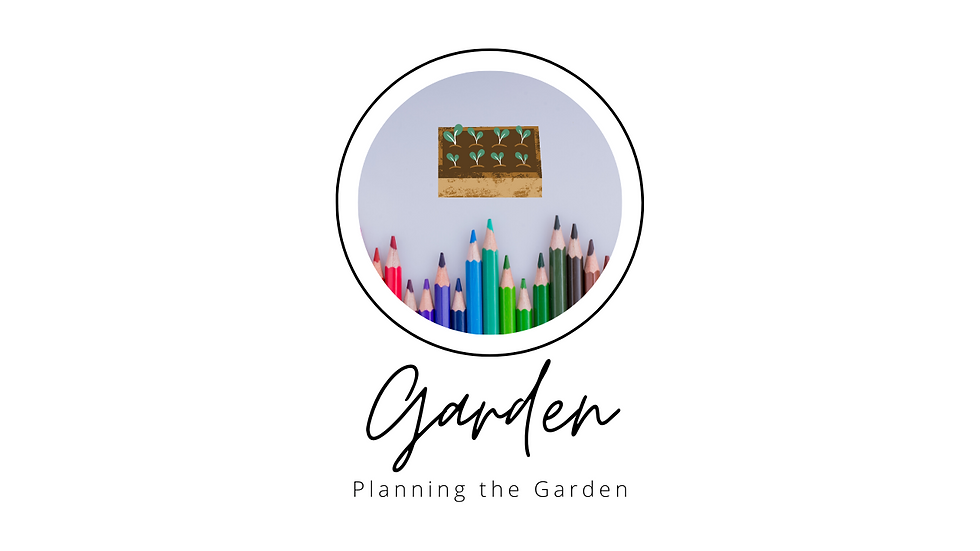
It's cold outside due to Winter, so it's a great time to plan your garden. You can of course do spontaneous garden but the benefit with planning is it can deliver better production and results. The funny thing is that I'm an organizer and planner, but I've been a spontaneous gardener for years. Some of it was that I didn't focus on the garden at the right time. Spring would arrive and I would scramble to find plants. Now living a rural life, I am making the time and I'm determined to grow some of our own food. Sound like anyone else? Maybe not, but I know that we are all aware that groceries are breaking budgets all over the country. So, let's look at some ways to plan in the Winter for Spring and Fall.
Take an Account of Your Space & Supplies
If this is your first time or tenth time gardening, take a look at what your garden area is like and start taking notes of what you would like to add, change, or utilize. Also, evaluate your supplies.
How much space do you have for gardening? Do you want a big garden or small?
Pots, raised beds, open ground, half barrel, or an old wheel barrel? What are your options for planting? If it is a tight space, you can always do pots and vertical systems.
Indoors or outdoors? Indoors can point to hydroponics, which might be a great option for some folks.
What are things that worked the previous year? Things that didn't?
What repairs need to be made to beds, irrigation, pest control, trellises, etc?
Any new projects for creating your garden space? Plan and work on them before Spring, so you can focus on planting when the time comes.
What supplies will you need? Grow trays? Tags? Raised beds? Soil amendments?

Seed Inventory
There is no shame in buying plants from your local nursery, or store. That being said, if you can do seeds, you should try as it is a money saver in the long run. It may not seem that way comparing a seed packet to a plant at the store, but there are tons of "plants" in that packet and seed packets can last longer than the stamped date.
Furthermore, seeds give you an opportunity to try new things as stores will have limited selections. Baker Creek for an example is full of beautiful unique seeds you can't find at Lowe's or even local nurseries. Check out these snow peas I'm growing right now. Okay, onto seed inventory.
Previous Seeds - If you have previously bought seeds, what do you have? Opened and unopened. Take an account of your seed packets and seeds you harvested (that's something you can do with successful plants).
Seed Storage - Before you buy a ton of seeds, how will you store them because many seeds last longer if stored correctly. You can extend the packet over years. Store them in a cool (house temps) and dry place. Here are some great options.
Boxes - Airtight and plastic
Photo Box - Check this out
Photo Binders
File system - Filing cabinets are used by some gardeners, but another file system would work too that's smaller and less money.
Seed Catalog - You can do this with a journal, or spreadsheet. The benefit of a spreadsheet is that if you have a ton, you can use the "find" tool to easily search your seeds. Furthermore, you can have columns with information like - germination time, hardiness, plant needs, etc. For me, I use a spreadsheet and here it is for you:
*This seed spreadsheet also has a tab of how long seeds can last if stored correctly as it depends on each veggie. Also, there is a link on the spreadsheet for a germination test to test out your older seeds.
Seed Buying - What seeds do you want? After reviewing and organizing what you have, what would you like or need for your garden. Check out links for seed sites here, OR visit your local nursery.
Plant Inventory
You may have existing plants in the garden A lot of times this will be fruits like berries, vines, fruit trees, or some brassicas (looking at kale).
Do they need clean up, fertilizer, or pruning? This depends on each plant. For instance, to my knowledge, grape vines are pruned in the Winter and apples are pruned in the Summer. Regardless of the plant, cleaning up dead leaves are generally always a good call and can be used for mulch and composting.
Catalog the downfalls or successes from the previous year. I just keep this on another tab of my seed catalog. You could also use a journal or binder.
Any plants you want to get this year? Bare root fruit trees (don't come in a pot of soil) become available in the Winter as well as many berries, so it's not a bad time to go ahead and plant them. Just research their needs prior. For example, a dragon fruit is going to hate frost, while an apple needs it.
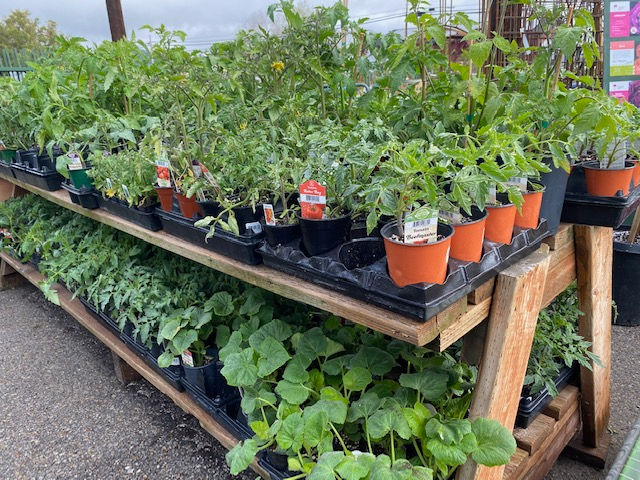
Planning Your Space
Now that you've evaluated your space and taken an inventory of plants and seeds, it's time to figure out where you are going to plant things.
Drawings - I feel taking graph paper and drawing out your garden space is the best approach. It visually helps you see what you have. You can always do a digital drawing with many softwares - Photoshop, Illustrator, Word, Excel, Sketch apps.
Numbering and/or Lettering - I think using a number and letter method for each bed helps you keep track of what bed is where, so when you catalog where you planted carrots, you write "B1" for example. Don't make it complicated and make it something easy for you.
Plant Needs - Looking at each plant's needs can help you determine where to plant.
Seed Depth - How deep do you need to plant?
Seed Sowing Space - How much space between each seed?
Type of Plant - Do you need deep soil for your beets? Do you need a trellis for your peas?
Sun Needs - Does it need sun, some shade, or shade? Make sure you don't have other plants blocking your sun loving plants, but use sun loving plants to provide shade to those that need some shade in the Summer.
Companion Planting - This could and should be it's own post, but you can plant more than one plant per raised bed or ground bed. Here's a quick examples.
Plant companion plants that will help with pest control. For example - tomatoes, basil, and marigold. Marigolds are edible by the way.
Harvest Dates - When does a harvest occur for a plant? Some plants have continual harvests and will need a spot for the entire season. Other plants have one or short harvests that can mean the space can be utilized by another plant after harvest.
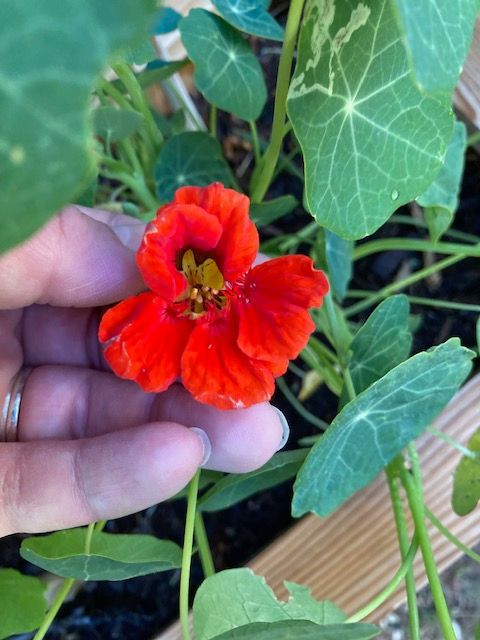
Calendar - Spring & Fall
This can go hand in hand with planning your garden space because your garden calendar does depend on space availability and frost dates. Some plants can be sown in the Spring, Summer, Fall, and Winter (yes, even winter). It just depends on the plant. This is where a seed catalog and plant catalog can help you keep track of what can go where and when. Then the calendar helps you execute it. Just figure out the frost date for your area and figure out the timing of each plant using the seed packets.
You can use a wall calendar, Google or Apple calendar, paper calendar, calendar in your journal, spreadsheet, or an app. There's a lot of ways to go about putting in the dates and setting up reminders. You can also add the seed starting dates as well as harvest dates.
Furthermore,You can actually plan your Fall garden in conjunction with your Spring garden.
"Okay, so peas are coming out this date, then beets can be planted this date for a Fall harvest. Then I can plant the mizuna lettuce before the Fall frost."
This means the garden space can be used more than once in a year and planned out for the year. It just depends on plant needs and harvest dates. The benefit of planning the rotation of a garden bed means you could have something to eat year round. It's up to you and your time.

Tools & Apps?
This sounds like a lot! It does require time, but here are some tools you can use to help you out.
Zones - Did a post on this, but here's the spot to figure out your USDA Zone.
Frost Dates - You can base it off experience with your zone, or you can use these sites to get a general idea: Almanac or PlantMaps. Just a thought, you could add a tab or part of your journal to track frost dates for each year.
Office Tools - You can use anything you use at the office... Word, Excel, Google Drive/Sheets/Docs/Calendar, iCalender, etc. It's up to you and the reason I don't list Apple's office tools is I personally don't like them like I do Microsoft and Google.
Old Fashioned - More into tactile, great! Use graph paper, printer paper, pens, pencils, rulers, and colored pencils to make it more creative. You can use a binder or a journal.
Seed Websites - Use the seed websites (ie: True Leaf Market) for more information on your seeds if the packet is short on info.
Apps - Yup, they've thought of it all. Here's some apps to help with planning if you're more of a digital person.
SeedTime - This website has a lot of the common plants already plugged into their system, so all you do is set up your zip code and input the plant and it automatically does the calendaring for you. I like it and it's free, but the paid version allows you to add more varieties and unique plants at $10 a month or $84 a year. If you are just doing basic plantings the free version would work just fine.
Garden Savvy - This allows you to "sketch" your garden with pretty good graphics and have a calendar. It's $34 a year. I didn't test this one out.
Planter - This app on your phone (or desktop) is pretty cool. You can do planter "drawings", learn about plants, and have a calendar. They also have a garden guide on the app. The free version is limited with garden planning (great for small gardens), but the paid version is $11.99 a year or $39.99 a lifetime. The affordable pick of the bunch.
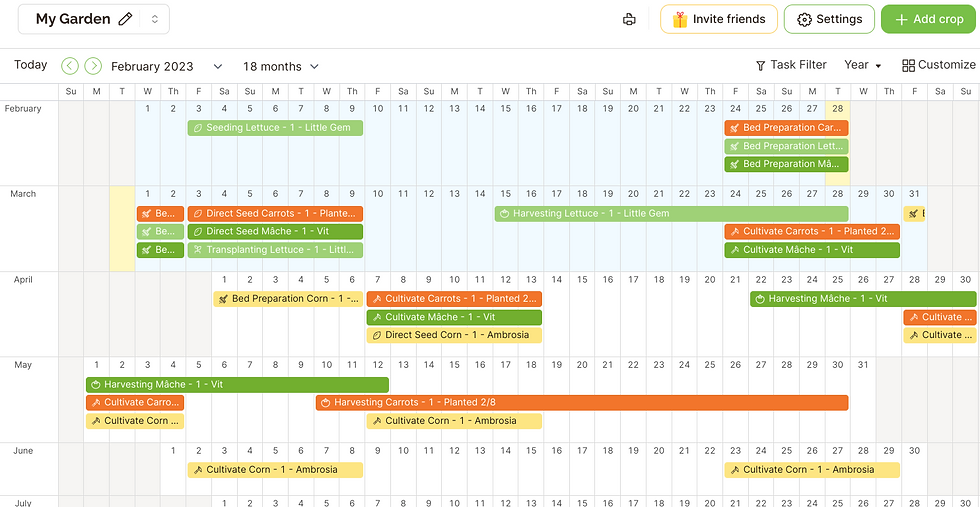
Pictured Above: SeedTime's calendar
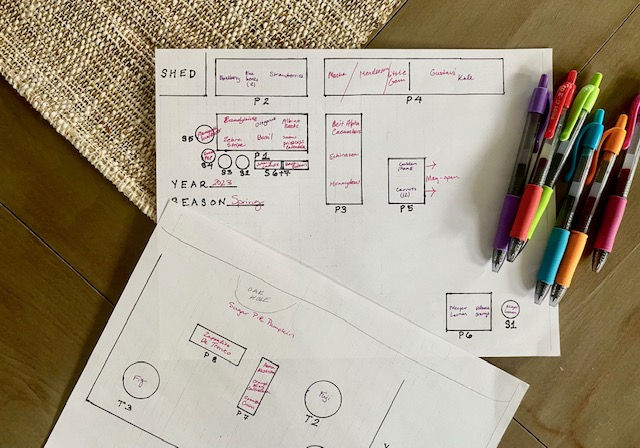
Pictured Above: I drew out my space on graph paper, then photo copied them to use for the future. Then I am using colored pens to fill in what goes where. Purple, existing plants. Pink, to do.
We just covered a lot of planning, but here's a few things to keep in mind...
At the end of the day, God is in control. You can plan all you want, but there will always be the unforeseen. Whether it is pests, unexpected weather (hello snow on the Central Coast), or failed germination...you can only control so much. That's agriculture and farmers are used to there being variables every year.
It's okay if you do not plan, or don't do a full garden. It's okay if you cannot be self sufficient like a homesteading pro. God is sufficient and will always provide where you cannot and that's a good thought to keep as food uncertainty may be a thing this year. We'll see.
Enjoy and learn. Make it a family thing, couples thing, community thing, or your hobby...have fun.
I'll wrap up this post with a quote because this post wasn't full of enough thoughts, but it's a great quote on using our time in general.
As we are all sowing, the great question we have to consider is "What will the harvest be?" - Charles Spurgeon
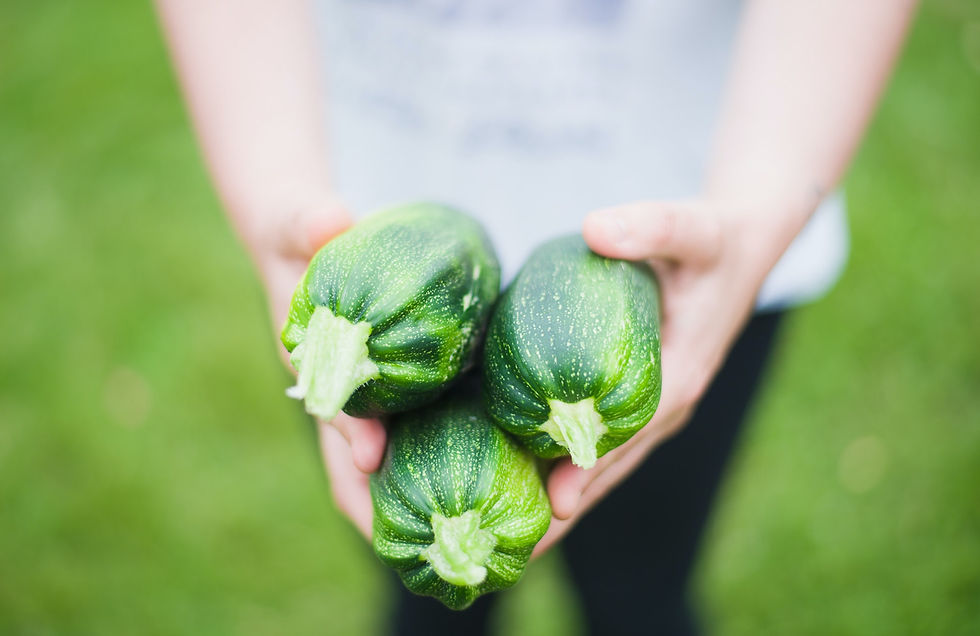






Comments